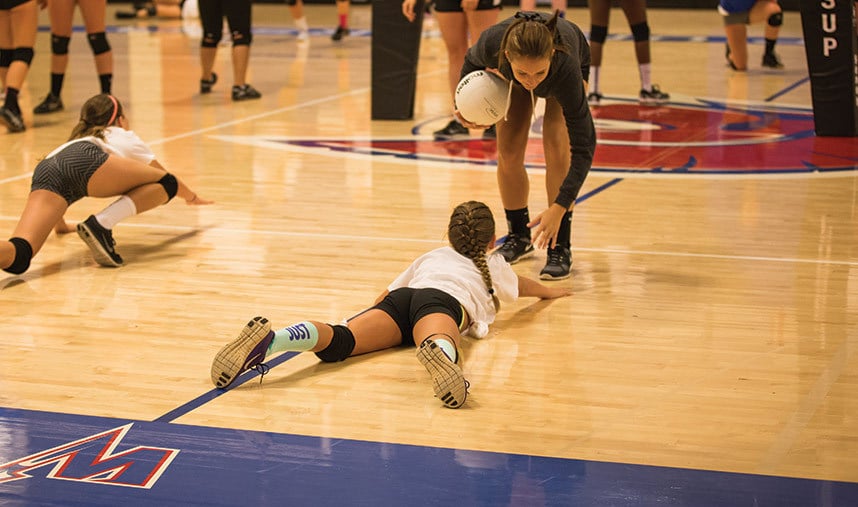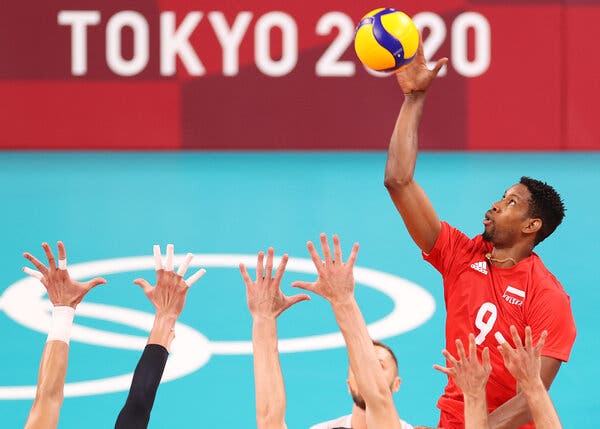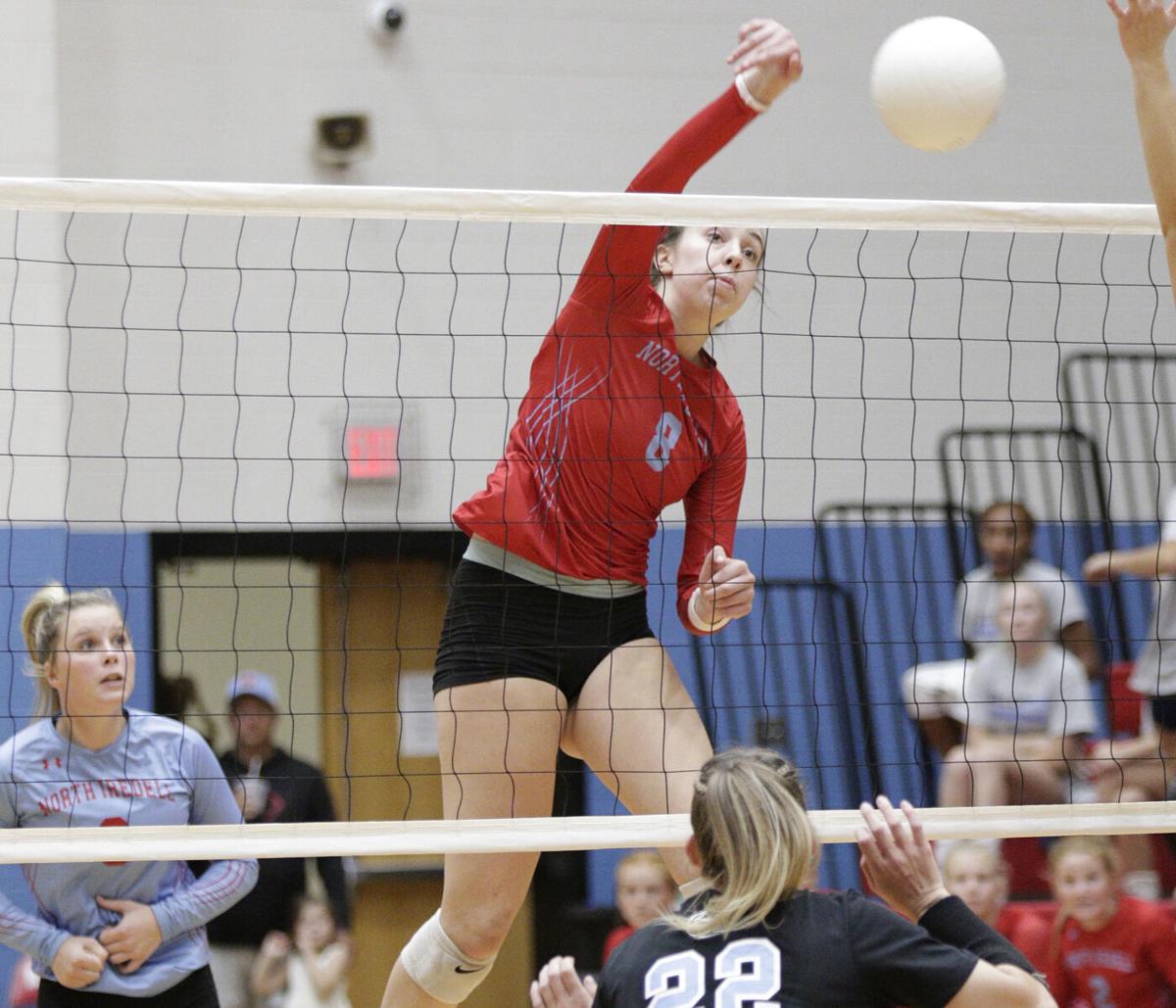Dive into Volleyball Safely: Pro Tips for Preventing Injury
To dive safely in volleyball, use proper technique and protective gear. Jump with two feet, land on your chest, and keep your head up to avoid injury.
Volleyball is a thrilling and competitive game. It requires players to be agile and make quick movements on the court. Diving is a vital skill in volleyball. However, diving inappropriately can result in injuries. To prevent any harm, players should use protective gear such as kneepads and ankle braces.
Proper technique is also crucial while diving. Players must jump with both feet, land on their chest, and keep their heads up to avoid any impact on their neck and head. This article will guide you on how to dive safely in volleyball without hurting yourself.

Credit: www.ussportscamps.com
Understanding The Importance Of Safe Volleyball Diving Techniques
Diving in volleyball is a common technique in the game. It requires players to hit the ground and slide under the ball to save it from hitting the ground, or to make a spectacular play. However, improper diving techniques can lead to serious injuries that could prevent you from playing not just volleyball, but other sports too.
In this post, we will discuss the importance of safe volleyball diving techniques.
The Potential Risks Of Improper Diving Techniques
Diving in volleyball can be dangerous if not executed correctly. Below are some of the potential risks associated with improper diving techniques:
- Wrist injuries: Landing on your wrist in a dive can cause sprains, strains, or even fractures. This can be especially dangerous for volleyball players who need their wrists for hitting and serving.
- Knee injuries: When you dive, you put a lot of pressure on your knees. Landing on them awkwardly can cause strains, sprains, dislocations, or even tears in ligaments or tendons.
- Head injuries: Hitting your head on the ground during a dive can cause concussions or other serious injuries.
To avoid these risks, it is important to develop proper diving techniques that will prevent injuries.
The Benefits Of Developing Correct Diving Techniques For Injury Prevention
Developing correct diving techniques can help prevent the above-mentioned injuries. Below are some of the benefits of proper diving techniques:
- Protection of body parts: Knowing how to land correctly will help protect your wrists and knees. Proper diving methods can shift the stress of the impact from your joints to the larger muscle groups.
- Reduced time off the court: If you suffer from an injury due to a fall or poor diving technique, you will need time to heal. This will take up valuable time that you could have spent practicing your game or playing with your team.
- Increased confidence: Knowing how to dive properly, will increase your confidence on the court. You will be able to make spectacular plays without the fear of getting hurt.
Proper diving techniques are an essential component of playing volleyball safely. By developing these skills, you can prevent injuries and stay on top of your game.
Essential Steps To Master Safe Volleyball Diving Techniques
Focusing On Proper Body Alignment During Approach And Takeoff
When preparing to dive in volleyball, perfecting your body alignment during approach and takeoff can prevent injuries. Consider these essential steps:
- Angle your non-dominant foot toward the direction you want to dive.
- Keep your knees slightly bent to maintain balance.
- Keep your body weight slightly on the balls of your feet.
- Keep your arms close to your body and swing them back to create momentum for the dive.
Developing Good Landing Mechanics And Body Control
How you land during a dive can make or break the success of your technique and can lead to injuries if done improperly. Follow these tips for good landing mechanics and body control:
- Keep your arms slightly bent during the landing to prevent impact on your wrists and elbows.
- Allow your body to take a roll to absorb the impact of the dive.
- Keep your head up to avoid hitting the floor with your face or head.
- Keep your hands, core, and legs engaged and in control during the landing.
Practicing In A Safe And Controlled Environment
A safe and controlled environment is crucial when practicing volleyball dives. Consider these tactics to create a safer environment for your practice sessions:
- Use a padded surface or a mat to cushion the impact of your landings.
- Always wear proper volleyball gear, including kneepads and ankle braces.
- Practice with a partner who can help you focus on technique and safety.
- Practice in a gym or outdoors with proper lighting to prevent accidents.
Types Of Volleyball Diving Techniques
Volleyball is an exciting game that requires physical agility, speed, and excellent jumping ability. However, with these actions come the risk of injuries such as sprains, strains, and bruises. Therefore, it is essential to learn proper diving techniques to minimize the chances of hurting yourself.
This blog post will discuss the two types of volleyball diving techniques: front and back diving techniques.
Front Diving Techniques
- Rolling dive – this is a common diving technique in volleyball. It involves diving forward and rolling over your shoulder to avoid landing directly on your chest.
- The sprawl dive – this technique is ideal for balls that are low to the ground. It involves diving forward with your legs apart and your arms extended to avoid landing on your belly.
- The power dive – used when the ball is far from your reach, this technique involves running towards the ball and diving forward with your arms stretched towards the ball.
Back Diving Techniques
- The back roll – this technique is useful when the ball is flying above your head, and you have to dive backward. It involves rolling over your shoulder and landing on your back.
- The back arch – this technique is used when a player has to dive backward to receive the ball. It involves arching your back and extending your arms to reach the ball.
- The one-handed save – this technique is ideal for balls that are slightly above you and behind you. It involves diving backward and extending only one hand to touch the ball.
Mastering these diving techniques will require practice, focus, and patience. Therefore, take time to practice each technique until you’re comfortable with it. Remember, one poor technique can lead to severe injuries, affecting your performance on and off the court.
Top Common Volleyball Diving Mistakes And How To Avoid Them
Volleyball diving is one of the most critical skills required in the game. However, it is also a skill that comes with high risks of getting hurt if not done properly. Certain common mistakes can cause serious injuries or, at the very least, make the player feel sore for days.
Here are some of the top mistakes players make when diving in volleyball and how to avoid them:
Lack Of Proper Technique
Diving in volleyball requires the right technique to prevent injuries. Here are some tips to help you dive the right way:
- Keep your arms in front of you when diving.
- Tuck in your chin and extend your arms as you fall to the ground.
- Bend your knees as you land.
- Avoid diving with your knees or chest hitting the ground first.
- Practice proper techniques to avoid getting hurt.
Lack Of Body Control
Having good body control is also essential to avoid injuries. Here are some tips to improve your body control while diving:
- Practice balance and coordination drills to improve your body control.
- Control your body movements as you dive by keeping an eye on the ball while making contact.
- Aim for the ground with your open palms to prevent injuries.
Landing Flat On The Stomach Or Back
Landing flat on your stomach or back increases the impact, leading to injuries. Here are tips to avoid landing flat:
- Tilt your head to the side while diving to avoid landing on your head and neck.
- Arch your back to avoid landing flat on your stomach or back.
- Raise one arm and opposite leg to avoid landing flat on your stomach or back.
Landing On The Wrong Body Part
Landing on the wrong body part is one of the most common mistakes and causes the most injuries. Here are some tips to avoid landing on the wrong body part:
- Aim to land on your hip, thigh, or forearm to distribute the impact evenly.
- Learn how to roll to avoid landing on your chest or face.
Diving in volleyball can be risky, but when done right, it is a valuable skill. Avoiding these common mistakes by practicing proper technique and improving your body control can make you a better player while keeping you safe. Practice the right way, and you’ll be diving like a pro in no time!
Prevention And Management Of Volleyball Diving Injuries
Volleyball is an intense sport that requires quick reflexes, agility, and precise movements. During the game, players often have to dive to save the ball, and this could result in injuries. To prevent and manage these injuries, there are several strategies that players should follow.
Common Types Of Volleyball Diving Injuries
Volleyball players can suffer from various types of injuries due to diving. Some of the most common include:
- Sprains: This happens when a ligament is stretched or torn.
- Strains: These occur when a muscle or tendon is stretched or torn.
- Fractures: This is a break in a bone.
- Contusions: This happens when a body part is hit, leading to muscle and tissue damage.
Steps To Take When An Injury Occurs
If an injury occurs while diving, several steps need to be taken right away, such as:
- Stop playing immediately: Continuing to play with an injury can make it worse.
- Apply ice: Applying ice will help reduce swelling and pain.
- Elevate the affected area: Elevating the injury helps to reduce blood flow, thereby reducing swelling.
- Compress the affected area: This helps to reduce swelling and limits movement.
Prevention Strategies
To prevent diving injuries, players can follow the following strategies:
- Wear proper protective gear: This includes knee pads, ankle braces, and other supportive gear.
- Proper warm-up: Warming up before playing helps to prepare the body for the physical activity.
- Strengthening exercises: Engage in strengthening exercises such as leg curls and squats to improve your leg muscles.
- Balance exercises: Balance exercises such as standing on one leg can improve your balance and stability while playing.
- Practice proper technique: Learning proper diving techniques can help prevent injuries.
- Stay in shape: Players need to be in good physical shape to play volleyball properly.
Diving injuries can be prevented and managed by following proper techniques and strategies. By being cautious and following these tips, players can avoid painful injuries that could hamper their game.
Importance Of Prioritizing Injury Prevention
The Importance Of Prioritizing Injury Prevention
As with any physical activity, playing volleyball can pose a risk of injury. However, by prioritizing injury prevention techniques, you can reduce the likelihood of getting hurt and enjoy the game to the fullest. Here are some key points to consider when it comes to preventing volleyball injuries:
- Warm up properly before playing: Warming up helps prepare your muscles and joints for exercise, making them less susceptible to injury. Try including movements that mimic the motions used in volleyball, such as lunges or jumping jacks.
- Wear appropriate gear: Wearing the correct gear can help safeguard you against injury. This includes supportive shoes with good traction, knee pads, and ankle braces if necessary.
- Focus on technique: Proper technique is crucial for injury prevention in volleyball. Make sure you know the proper form for jumping and landing, serving, and spiking to avoid unnecessary strain on your body.
- Listen to your body: Pain or discomfort is a signal that something may be wrong. Don’t push through the pain; take a break or seek medical attention if needed.
- Build strength and flexibility: Improving your strength and flexibility can reduce your risk of injury. Consider incorporating exercises such as squats and lunges to build leg muscles, and stretches for the hips and shoulders.
- Stay hydrated and nourished: Proper hydration and nutrition can help keep your body performing at its best. Be sure to drink plenty of water and eat a balanced diet with adequate protein and nutrients.
By prioritizing injury prevention and taking steps to protect your body, you can enjoy playing volleyball without risking injury.
The Benefits Of Better Body Awareness And Improved Mechanics
Better Body Awareness
One of the key components of diving in volleyball is having an acute awareness of your body’s position and placement. Here are two crucial benefits of improving your body awareness:
- Fewer injuries: Any athlete knows that injuries are all too common in sports. However, the better you become at body awareness, the less likely you are to sustain injury because you will recognize and correct potential problems before they lead to an injury.
- Improved coordination: Knowing where your body is at all times is crucial for developing good coordination. Increased body awareness means improved coordination, which makes it easier to execute the movements required for a successful dive.
Improved Mechanics
In addition to body awareness, better mechanics will also greatly improve your diving ability. Here are a few key points regarding the importance of good mechanics:
- Proper timing: Timing is everything when it comes to diving in volleyball. Proper mechanics help ensure that you are diving at the right time, hitting the ground correctly, and minimizing the impact on your body.
- Greater efficiency: Good mechanics also make your body’s movements more efficient. This means you can make the most out of every dive, using your energy more efficiently to execute the move.
- Improved accuracy: Finally, good mechanics can also improve the accuracy of your dives. When you understand the correct movements and timing, you are more likely to make a successful, accurate dive.
Encouragement To Incorporate Safe Diving Techniques Into Daily Practice Routines.
Encouragement To Incorporate Safe Diving Techniques Into Daily Practice Routines
Volleyball is an exciting sport that requires excellent body coordination and control. Proper diving techniques are essential for a successful game, and they can also help to avoid injuries. Here are some key points to remember as you incorporate safe diving techniques into your daily practice routines.
- Focus on proper form: To avoid injury, it is crucial to focus on proper diving form. Keep your head up, hands out in front of you, and tuck your chin to your chest as you go into the dive. Remember to use your upper body strength to push yourself back up and return to your feet as quickly as possible.
- Gradual progression: Incorporate diving techniques into your daily routines in a gradual, systematic way, starting with shallow dives and working your way up to deeper dives as your technique improves.
- Use proper equipment: Make sure you have the appropriate equipment for safe diving. Knee pads and elbow pads are essential to protect your joints from the impact of diving, and quality volleyball shoes can provide excellent traction on the court.
- Consistency in practice: Practice makes perfect, and it’s essential to stay consistent with your diving techniques to build confidence and master the skill. Repeatedly practicing safe diving techniques can also help to reduce the risk of injury.
By incorporating safe diving techniques into your daily practice routines, you can develop good habits and improve your overall performance on the court. Remember to stay conscious of your form and use the appropriate equipment to ensure that your dives are both safe and effective.
Frequently Asked Questions For How To Dive In Volleyball Without Hurting Yourself
How Do I Dive In Volleyball Without Hurting Myself?
To dive without injury, start low, keep your knees bent, and lead with your hips.
What Are The Most Common Volleyball Diving Injuries?
Common injuries include bruises, sprains, and contusions. But proper technique can minimize risks.
How Can I Improve My Diving In Volleyball?
Work on your core strength to maintain balance, and practice proper technique. With time and effort, you’ll improve.
Conclusion
Diving in volleyball can improve your game but it can also lead to potential injuries if not executed properly. By following the guidelines mentioned in this post, including proper technique, wearing protective gear, and gradually increasing intensity over time, you can minimize your risk of getting hurt.
Remember to always warm up, stretch, and listen to your body during practice or games. Incorporating these tips into your training can not only help you dive confidently on the court, but also improve your overall game. By taking care of your body and investing in safe techniques, you’ll be able to continue participating in your favorite sport for years to come.
So get your head in the game, practice, and give your best performance with safe and carefully executed dives every time.



